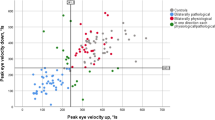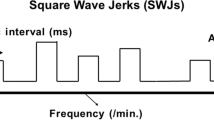Summary
Saccadic eye movements were examined by infrared reflection oculography in 22 patients with suspected myasthenia gravis. In all of them the diagnosis was confirmed either by electromyography, by the presence of acetylcholinereceptor antibodies (15 cases), by a positive clinical Tensilon test (4 cases), or by the course of the disease (3 cases). The aim of the study was to find out which of the saccade disorders described in myasthenic patients can be found in the early stage of the disease, and to discover their diagnostic value. Typically, saccade abnormalities were also seen in clinically uninvolved eyes. Intrasaccadic disorders mainly consisted of “decrescendo” of the velocity profiles (two-thirds of the cases) and “hypometria” (half of the cases). Postsaccadic “waver” was present in about two-thirds of the patients. The most frequent finding was “intersaccadic variation” (i.e., variation between repeated corresponding saccades) which occurred in 18 of the 22 patients, and particularly affected the velocity profiles. A standardized fatigue test proved to be useful in accentuating mild, or provoking latent pathology in most of the patients. A standardized combined examination of saccades with Tensilon yielded pathological results less frequently than hitherto described in the literature. In 4 of the 9 patients with purely ocular myasthenia gravis oculography led to the diagnosis. The problems in attempting to delimit the observed saccade abnormalities from those found in other eye movement disorders are discussed.
Similar content being viewed by others
References
Bahill AT, Clark MR, Stark L (1975) Dynamic overshoot in saccadic eye movements is caused by neurological control signal reversals. Exp Neurol 48:107–122
Bever CT, Aquino AV, Penn AS, Lovelace RE, Rowland LP (1983) Prognosis of ocular myasthenia. Ann Neurol 14:516–519
Bittencourt PRM, Wade P, Smith AT, Richens A (1981) The relationship between park velocity of saccadic eye movements and serum benzodiazepine concentration. Br J Clin Pharmacol 12: 523–533
Dell'Osso LF, Ayyar DR, Daroff RB, Abel LA (1983) Edrophonium test in Eaton-Lambert syndrome: Quantitative oculography. Neurology 33:1157–1163
Engel AG (1984) Myasthenia gravis and myasthenic syndromes. Ann Neurol 16:519–534
Feldon SE, Hoyt WF, Stark L (1980) Disordered inhibition in internuclear ophthalmoplegia. Analysis of eye movement recordings with computer simulations. Brain 103:113–137
Feldon SE, Stark L, Lehman SL, Hoyt WF (1982) Oculomotor effects of intermittent conduction block in myasthenia gravis and Guillain-Barre Syndrome. Arch Neurol 39:497–503
Glaser JS (1966) Myasthenic pseudointernuclear ophthalmoplegia. Arch Ophtalmol 75: 363–366
Grob D, Brunner NG, Namba T (1981) The natural course of myasthenia gravis and effect of therapeutic measures. Ann NY Acad Sci 377: 652–669
Hess CW, Müri R, Meienberg O (1986) Recording of horizontal saccadic eye movements: Methodological comparison between electro-oculography and infrared reflection oculography. Neuroophthalmol 6:189–198
Huber A (1980) Ocular myasthenia - diagnosis and treatment. Excerpta Medica Internat Congress Series Amsterdam 508:42–53
Jürgens R, Becker W, Kornhuber HH (1981) Natural and drug-induced variations of velocity and duration of human saccadic eye movements: Evidence for a control of the neural pulse generator by local feedback. Biol Cybern 39:87–96
Kelly JJ, Daube JR, Lennon VA, Howard FM, Younge BR (1982) The laboratory diagnosis of mild myasthenia gravis. Ann Neurol 12:238–242
Limburg PC, The TH, Hummel-Tappel E, Oosterhuis HJGH (1983) Anti-acetylcholine receptor antibodies in myasthenia gravis. Part 1. Relation to clinical parameters in 250 patients. J Neurol Sci 58:357–370
Mauri L, Meienberg O, Roth E, König MP (1984) Evaluation of endocrine ophthalmopathy with saccadic eye movements. J Neurol 231:182–187
Meienberg O, Burgunder JM (1985) Saccadic eye movement disorder in cephalic tetanus. Eur Neuro 24:182–190
Meienberg O, Müri RM, Rabineau PA (1986) Clinical and oculographic examination of saccadic eye movements in the diagnosis of multiple sclerosis. Arch Neurol 43:438–443
Meienberg O, Burkhalter R (1986) A new head frame for routine recordings of horizontal eye movements with the infrared reflection method. 30th annual meeting of the German EEG-society, 10–12 October 1985, Munich. Electroencephalogr Clin Neurophysiol (Abstract) (in press)
Oda K, Ito Y (1981) Myasthenia gravis: Antibodies of acetylcholine receptor in ocular myasthenia gravis. J Neurol 225:251–258
Oezdemir C, Young RR (1976) The result to be expected from electrical testing in the diagnosis of myasthenia gravis. Ann NY Acad Sci 274:203–225
Oh SJ, Eslami N, Nishihira T, Sarala PK, Kuba T, Elmore RS, Sunwoo IN, Ro YI (1982) Electrophysiological and clinical correlation in myasthenia gravis. Ann Neurol 12:348–354
Oohira A, Goto K, Ozawa T (1985) Slow saccades in myogenic and peripheral neurogenic ophthalmoplegia. Latent ocular myopathy in myotonic dystrophy. Neuro-Ophthalmol 5:117–123
Oosterhuis HJGH (1982) The ocular signs and symptoms of myasthenia gravis. Doe Ophthalmol 52: 363–378
Osserman KE (1967) Ocular myasthenia gravis. Invest Ophthalmol 6:277–287
Pierrot-Déseilligny C, Michelin T (1983) Pseudo-ophthalmoplegie internucléaire myasthénique. Rev Neurol 139:527–528
Rothenberg SJ, Selkoe D (1981) Specific oculomotor deficit after Diazepam. 1. Saccadic eye movements. Psychopharmocology 74: 232–236
Schlaginhaufen W, Meienberg O, Fisch HU (1984) Sakkadische Augenbewegungen als Maf3 fur die Pharmakodynamik von Benzodiazepinen. Bewertung verschiedener okulographischer Parameter. Z EEG-EMG 15:145–150
Schmidt D, Abel LA, Dell'Osso LF, Daroff RB (1979) Saccadic velocity characteristics: Intrinsic variability and fatigue. Aviat Space Environ Med 50:393–395
Schmidt D, Dell'Osso LF, Abel LA, Daroff RB (1980a) Myasthenia gravis: Saccadic eye movement waveforms. Exp Neurol 68:346–364
Schmidt D, Dell'Osso LF, Abel LA, Daroff RB (1980b) Myasthenia gravis: Dynamic changes in saccadic waveforms, gain and velocity. Exp Neurol 68: 365–377
Slomic A, Rosenfalck A, Buchthal F (1968) Electrical and mechanical responses of normal and myasthenic muscle.Brain Res 10:1–78
Sonderegger EN, Meienberg O, Ehrengruber H (1986) Normative data of saccadic eye movements for routine diagnosis of ophthalmologic disorders. Neuro-Ophthalmol (in press)
Spooner JW, Baloh RW (1979) Eye movement fatigue in myasthenia gravis. Neurology 29:29–33
Yee RD, Cogan DG, Zee DS, Baloh RW, Honrubia V (1976) Rapid eye movements in myasthenia gravis. II. Electro-oculographic analysis. Arch Ophthalmol 94:1465–1472
Zee DS, Chu FC, Leigh RJ, Savino PJ, Schatz NJ, Reinhold DB, Cogan DG (1983) Blink-saccade synkinesis. Neurology 33:1233–1236
Author information
Authors and Affiliations
Rights and permissions
About this article
Cite this article
Sollbergert, C.E., Meienberg, O. & Ludin, H.P. The contribution of oculography to early diagnosis of myasthenia gravis. Eur Arch Psychiatr Neurol Sci 236, 102–108 (1986). https://doi.org/10.1007/BF00454019
Received:
Issue Date:
DOI: https://doi.org/10.1007/BF00454019




